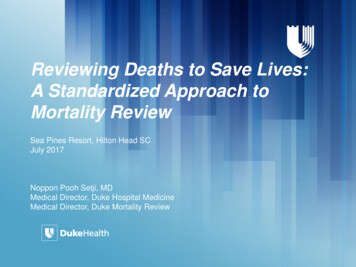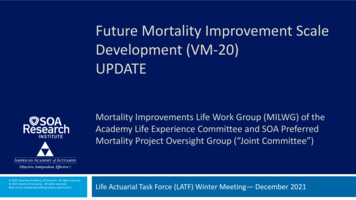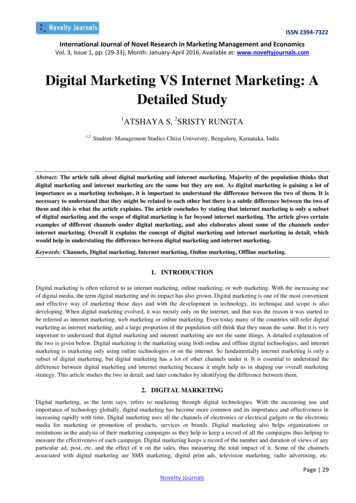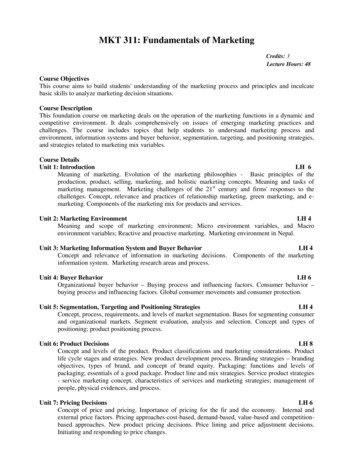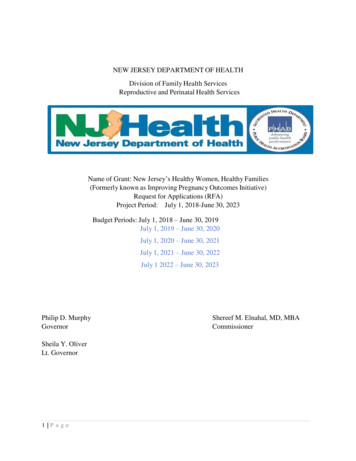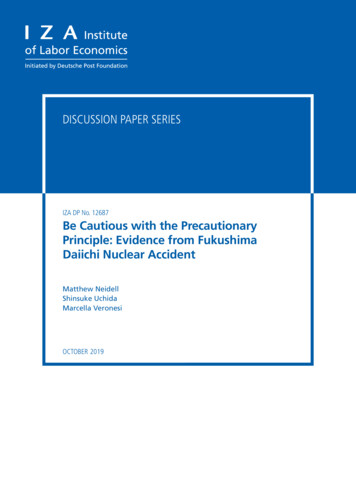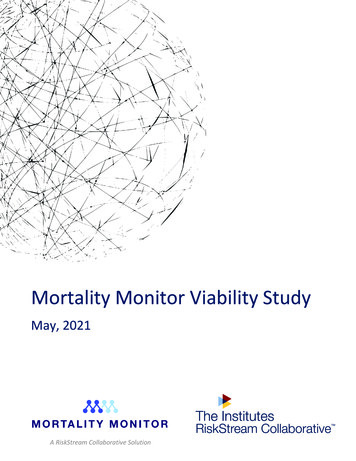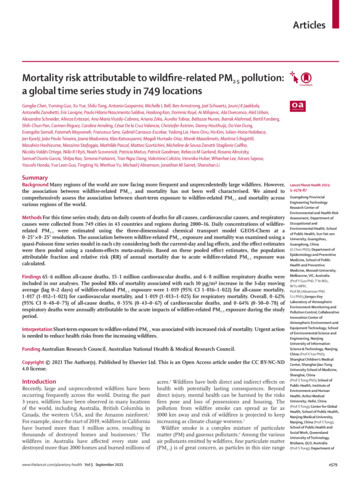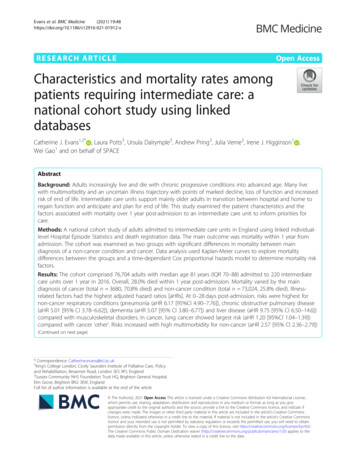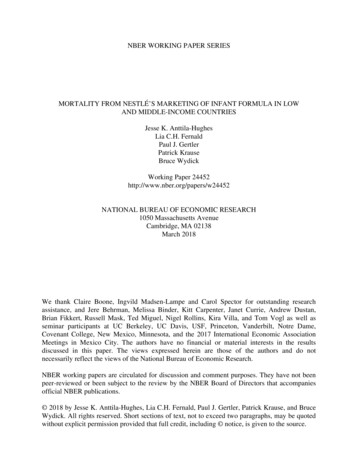
Transcription
NBER WORKING PAPER SERIESMORTALITY FROM NESTLÉ’S MARKETING OF INFANT FORMULA IN LOWAND MIDDLE-INCOME COUNTRIESJesse K. Anttila-HughesLia C.H. FernaldPaul J. GertlerPatrick KrauseBruce WydickWorking Paper 24452http://www.nber.org/papers/w24452NATIONAL BUREAU OF ECONOMIC RESEARCH1050 Massachusetts AvenueCambridge, MA 02138March 2018We thank Claire Boone, Ingvild Madsen-Lampe and Carol Spector for outstanding researchassistance, and Jere Behrman, Melissa Binder, Kitt Carpenter, Janet Currie, Andrew Dustan,Brian Fikkert, Russell Mask, Ted Miguel, Nigel Rollins, Kira Villa, and Tom Vogl as well asseminar participants at UC Berkeley, UC Davis, USF, Princeton, Vanderbilt, Notre Dame,Covenant College, New Mexico, Minnesota, and the 2017 International Economic AssociationMeetings in Mexico City. The authors have no financial or material interests in the resultsdiscussed in this paper. The views expressed herein are those of the authors and do notnecessarily reflect the views of the National Bureau of Economic Research.NBER working papers are circulated for discussion and comment purposes. They have not beenpeer-reviewed or been subject to the review by the NBER Board of Directors that accompaniesofficial NBER publications. 2018 by Jesse K. Anttila-Hughes, Lia C.H. Fernald, Paul J. Gertler, Patrick Krause, and BruceWydick. All rights reserved. Short sections of text, not to exceed two paragraphs, may be quotedwithout explicit permission provided that full credit, including notice, is given to the source.
Mortality from Nestlé’s Marketing of Infant Formula in Low and Middle-Income CountriesJesse K. Anttila-Hughes, Lia C.H. Fernald, Paul J. Gertler, Patrick Krause, and Bruce WydickNBER Working Paper No. 24452March 2018JEL No. I14,I15,O15ABSTRACTIntensive and controversial marketing of infant formula is believed to be responsible for millionsof infant deaths in low and middle-income countries (LMICs), yet to date there have been norigorous analyses that quantify these effects. To estimate the impact of infant formula on infantmortality, we pair country-specific data from the annual corporate reports of Nestlé, the largestproducer of infant formula, with a sample of 2.48 million births in 46 LMICs from 1970-2011.Our key finding is that the availability of formula increased infant mortality by 9.4 per 1000births, 95%CI [3.6, 15.6] among mothers without access to clean water, suggesting that uncleanwater acted as a vector for the transmission of water-borne pathogens to infants. We estimate thatthe availability of formula in LIMCs resulted in approximately 66,000 infant deaths in 1981 at thepeak of the infant formula controversy.Jesse K. Anttila-HughesUniversity of San Francisco2130 Fulton St.Cowell Hall 407San Francisco, CA 94110jesse.anttilahughes@gmail.comLia C.H. FernaldSchool of Public HealthUniversity of California Berkeley,CA 94720fernald@berkeley.eduPaul J. GertlerHaas School of BusinessUniversity of California, BerkeleyBerkeley, CA 94720and NBERgertler@haas.berkeley.eduPatrick KrauseProtagonist TechnologySan Francisco, Californiapatrick.krause2@gmail.comBruce WydickDepartment of EconomicsUniversity of San FranciscoSan Francisco, CA 94117wydick@usfca.edu
1.IntroductionThere is strong scientific consensus that breastfeeding is optimal for child health anddevelopment (1-3). The World Health Organization (WHO) recommends that infants arebreastfed within an hour birth, exclusively breastfed for the first 4-6 months of life, and thencontinue to receive breastmilk for up to two years (4). A recent meta-analysis presentedevidence on the importance of breastfeeding for child survival due to the unique biologicalcontribution of breast milk to the child’s immune response (5). The risk of all-cause mortalityis substantially lower in children who are exclusively breastfed for the first 5 months of theirlives when compared with children who are either partially breastfed or not breastfed at all,receiving breastmilk substitutes instead (e.g. infant formula) (6). Children who receivebreastmilk instead of a breastmilk substitutes benefit from reduced severity of diarrhealdisease and respiratory infections (7), benefits in cognitive function (5), and longer-termbenefits for cardiovascular health (8). In 2012, the estimated aggregate economic loss fromshortened breastfeeding was 302 billion, and that 820,000 infant lives per year could besaved if breastfeeding were increased to near universal levels (9).Despite the scientifically supported benefits of breastfeeding, the use of infantformula as an alternative to breast milk remains widespread (10). Less than half ofnewborns worldwide are breastfed within an hour of birth, and only 43% are exclusivelybreastfed from birth to 6 months (11). There are many reasons cited for why a mother maychoose to use infant formula over breastfeeding, including insufficient or the perception ofinsufficient breast milk, lack of ability to pump breast milk at work, lack of family support,depression, poverty, and other socio-cultural factors (12-14).A key factor contributing to low rates of breast feeding has been the private sectordevelopment and marketing of infant formula (15). Globally, the sales of infant formulatotaled US 44.8 billion in 2016, and are expected to rise to US 70.6 billion by 2019 (16). Inthe early part of the 20th century, companies in the United States and Europe developedcommercial breast milk substitutes, partly in response to demand from women who haddifficulty breastfeeding. The use of infant formula rose steadily in the industrialized worldwith post World War II baby boom breastfeeding rates dropping by half from earlier in thecentury (17). Formula sales in the United States peaked in the 1950s and began to recede in1
the 1960s due both to lower birth rates and mothers returning to breastfeeding. Infantformula companies then looked to new markets in the developing world to make up fallingrevenues, raising widespread alarm among public health and humanitarian advocacygroups.The beginning of the public controversy over infant formula marketing practices inthe developing world began in August 1973 when an article, The Baby Killer, was publishedin the New Industrialist. The article stressed the nutritional inadequacy of infant formularelative to breast milk (18), and provided examples of specific marketing abuses by Nestlé,the first major formula manufacturer to enter LMICs (19) and the largest supplier worldwide(20).1 At the same time, public health researchers documented a large decline in breastfeeding contemporaneous with the introduction of infant formula (Figure 1), and publishedestimates of infant deaths resulting from the introduction of infant formula into LMICsranging from annual figures of 1 million to 10 million (21, 22). The article and researchbecame catalysts for activism against the infant formula industry, which ultimately led to aninternational boycott of Nestlé products starting in 1977 and public hearings on the Nestlécontroversy in the U.S. Senate in May 1978 (17).In response, the World Health Organization and UNICEF organized a meeting ofstakeholders out of which the International Code of Marketing of Breast-milk Substitutes(ICMBS) was created and later enacted in 1981 (23). Nestlé, faced with the boycott, lawsuits,and increasing public pressure, eventually agreed to abide by the ICMBS in 1984. However,in 1988 the International Baby Food Action Network called for a reinstatement of the boycottafter evidence was produced that Nestlé had returned to marketing practices banned by theICMBS (24-26, 33).Nestlé was accused of providing health clinics with free or low-cost supplies of infantformula, often dispensed by “milk nurses” (saleswomen dressed in nurses uniforms), toencourage new mothers in the use of infant formula (24-26). This practice is particularlyegregious because formula use among neonates increases the risk that mothers release theprolactin-inhibiting factor, which signals their milk production to shut down, thereby1Nestle has consistently denied allegations of unethical marketing (17).2
creating a future dependence on breast milk substitutes (27). In addition, critics wereconcerned that Nestlé’s marketing included promoting formula to mothers unlikely to haveaccess to clean water and likely to possess limited technical understanding of nutrition,physiology, or disease mechanisms due to relatively little formal education (19).Inappropriately prepared formula (e.g. mixed with unclean water, or mixed with too muchwater), can increase the risk of infant mortality due to the increased likelihood of diarrheaand other intestinal infections (28).In this paper we present, to our knowledge, the first causal estimates of the effect oninfant mortality of Nestlé’s entrance into LIMC formula markets for the both populationoverall, and for vulnerable subpopulations believed to be most at risk. Nestlé’s phasedgeographic entry into national infant formula markets over time in LMICs provides plausiblyexogenous variation in the market availability of formula conditional on location fixedeffects. We exploit this variation to identify the causal effect of formula availability usingdifference-in-differences and event-history models. We estimate these models by combiningdata on the timing of formula imports provided in Nestlé’s own annual corporate report withdata on infant mortality from 2.48 million individual birth records in 48 countries for 1970through 2011 collected in Demographic and Health Surveys (DHS) (29).2.DataInfant Formula Availability: Since Nestlé was the first major formula manufacturer toenter LMICs (19) and the largest supplier by far worldwide (20), we proxy infant formulabeing available in a country by whether Nestlé was actively marketing and selling formula inthat country. Annual data on the countries where Nestlé sells infant formula are found inNestlé’s 1966 to 2014 corporate annual reports, in the Manufacturing and Sale of Productssection describing international market activity (Supplementary Materials Figure A). We8exclude six countries where there was already local production of formula before 1966.Infant Mortality: We merged Nestlé’s information on infant formula availability in acountry with individual infant birth and mortality records from the Demographic and HealthSurveys (DHS), a set of nationally and regionally representative surveys of women betweenthe ages of 15 and 49, covering a large sample of low and middle-income countries. We3
identified all DHS countries for which Nestlé began selling formula between 1966 and 2014,creating a sample of all children born within the /- 5 years surrounding the year formulaimports began, and added control countries from the same geographic region as eachtreatment country, leaving us with a sample of the 18 treated countries and 28 controlcountries, for a total sample of 2,478,842 children in 46 countries as seen in Table 1.The DHS survey includes recall data for all children including date of birth, and age atdeath if the child died, allowing us to construct location and year-specific infant-levelmortality data set. We designate any death of a child age 12 months or younger as infantmortality and rescale the variable to deaths per thousand so as to yield rate-comparableestimates (in deaths per 1000 live births) for population prevalence.Maternal and Household Characteristics: We use several other variables of interesttaken at time of survey including children's basic demographic characteristics (sex, birthorder, date of birth), and mother's and household’s characteristics (education, type of wateraccess, asset quartile measure of wealth, and location). We use two indicators for broadlycomparable measures of socio-economic status: a variable indicating that the mother hascompleted less than primary education, and a variable indicating that a household is belowthe country median in the DHS’s asset index to proxy for household wealth.Appropriate preparation of powdered infant formula requires combining the powderwith clean drinking water; safe water is critically important here because mixing infantformula with unclean water presents a severe health risk to newborn infants. We measurea mother’s inability to access clean water using the DHS water source variable that indicatesthe water source most commonly used by the household. Surface water, the lowest-qualitywater source in the DHS, is the water source associated with the highest levels of infantmortality regardless of infant formula use (30). In our sample, surface water is used by15.4% of households.An indicator of surface water as the household’s primary water serves as our measureof poor water quality. We assume that any woman currently using unsanitary water waslikely to be doing so in the past. However, there is some measurement error in this variableas the steady decrease in unsanitary water use globally over this period implies that there4
are likely to be observations that had unsanitary water in the past but do not today.Improvements in water quality access in LMICs that have occurred since the birth of childrenin the dataset would likely attenuate our estimates of the impact on mortality for the sampledesignated to use unsafe water, implying that our estimates would be lower bound effects.Macroeconomic Data: To control for the possibility that the timing of Nestlé importsand choice of countries were endogenously related to economic conditions that could alsoaffect infant mortality, we include a set of country-level macroeconomic controls foreconomic growth and foreign investment. Data on Gross Domestic Product (GDP) per capitaand Foreign Direct Investment (FDI) were taken from the World Bank DevelopmentIndicators.3.Identification and EstimationNestlé’s phased entry over time into national infant formula markets providesplausibly exogenous variation in the market availability of formula conditional on locationfixed effects. We exploit this variation to identify the causal effect of formula availability byestimating difference-in-differences models with location and year fixed effects. Weinterpret the results as Intent-to-Treat (ITT) estimates that capture the average mortalityresponse to the availability of infant formula for purchase proxied by whether Nestlé isactively selling formula in the country. Our estimated treatment effects represent theintersection of adoption of infant formula by mothers within the exposed population andthe impacts on infants from consuming the formula. The impact on infant mortality willalso vary depending on whether formula is combined with clean water and whether itsubstitutes for breast milk or for some inferior nutritional supplementation such as water,diluted condensed milk, juice, rice water, or other low-quality substitute.Specifically, we estimate the following difference-in-differences model using a linearprobability specification:𝑚"# %& 𝛽𝑁"% 𝛼 𝛾& 𝜆"% 𝜑" 𝝁0 𝒁𝒋 𝝓′𝑪𝒄𝒕 𝜖"# %& ,(1)where 𝑚"# %& is an indicator variable equal to 1000 if child i died during or prior to his or her12th month of life to a mother in DHS region k, in country c, and in year t j and equals zero isthe child lived through its 12th month of life,; β is the treatment effect and is the coefficient5
on 𝑁"% , which indicates whether the child i was born in the five year period after Nestlé beganselling formula in country c; 𝛼 represents a regional fixed effect; 𝛾& is a fixed effect for yearof the child's birth; 𝜆"% is a vector of country birth-month fixed effects to control for countrylevel seasonality in mortality; 𝜑" is a gender birth order fixed effect for child i; 𝒁𝒋 is a vectorof mother and household-level characteristics that include household water access, mother’seducation, and whether the household is in the lowest wealth quartile in the country; 𝑪𝒄𝒕 isa vector of macroeconomic controls that includes GDP per capita and Foreign DirectInvestment in country c in year t, and 𝜖"# %& is the error term. We cluster the standard errorsat the level of the first-level DHS administrative unit, and weight the data using the DHSsurvey weights.We test whether the treatment effects are different for households that use surfacewater versus clean sources of water, low educated mothers versus high educated mothers,and poor households versus non-poor households. Specifically, we estimate versions ofequation (1) with interactions of β𝑁"% with indictors separately for surface water, loweducation, and poverty.Finally, we estimate an “event study” version of the difference-in-difference modelthat allows the treatment effects to vary in the years prior to and following formulaintroduction. Specifically,𝑚"# %& 𝛼 𝛾& 𝜆"% 𝜑" 𝝁0 𝒁𝒋 𝝓0 𝑪𝒄𝒕 & ; &? 𝜏 ;𝑇%; 𝜖"# %& ,(2)where coefficients in (2) are as in (1) except that 𝜏 ; is a set of 2m 1 coefficients thatrepresent a child’s birth in different years within the event window surrounding theintroduction of infant formula within a country. We use an event window in (2) that rangesfrom five years before (T -5) to five years after (T 5) Nestlé began selling formula. Theevent-study estimations allow us to examine pre-treatment trends before formulaintroduction and whether introduction of formula creates a break in these pre-treatmenttrends.6
4.ResultsTable 2 reports estimates of the average treatment effects for the mortality effect offormula from our difference-in-differences models. First, we note that drinking surfacewater, having low maternal education, and being in a below median poverty household allsignificantly predict increased mortality in all model specifications. Our estimates indicatethat a child born into a household in the bottom quartile of income that uses surface wateras its major source of drinking water, where the mother has less than primary education andlives in poverty has a 40.1 per 1000 live births higher probability of infant mortality, or 55%higher than the mean mortality rate of the sample.The introduction of infant formula shows no statistically significant average impacton infant mortality for the population as a whole (Table 2, Model 1). However, our resultsshow large and significant infant mortality deaths from formula introduction concentratedin vulnerable sub-populations. Specifically, infant formula availability had a significantlynegative effect on mortality of infants born in households that used surface water (Table 2,Model 2). The availability of formula increased infant mortality by 12.9 per 1000 forhouseholds that used surface water relative to higher-quality water using households. Thenet effect of formula availability is an increase of 9.4 infant deaths per 1000 among motherswith poor-quality water.We test whether exposure to surface water is a proxy for socioeconomic status byadding interactions of formula availability with indicators for both low maternal educationand below-median asset poverty (model 3). We find that the estimate is practicallyunchanged, and that mother’s education and wealth are insignificant. Thus, our resultsindicate it is the combination of infant formula availability and lack of clean water accessrather than poverty that drives our results.Although the combination of formula introduction and women’s education itself isinsignificant, we investigate whether uneducated mothers without clean water access weremore likely use infant formula in ways that put infant lives at risk, following reports that lesseducated mothers did not know that the surface water mixed with the formula needed to beboiled or purified in some other way (19). We investigate this using a triple interaction of7
formula availability with surface water and low mother’s education (model 4) and indeedfind that the elevated infant mortality from formula introduction is concentrated among lowliteracy mothers in surface-water using households. Estimating the effect of formulaavailability on just that group (model 5) confirms this result and shows an even strongerdifference of 14.2 per thousand relative to the high-quality water counterfactual group.Our event study estimates in Figure 2 show estimated differences in mortalitybetween those eventually treated countries and those not treated for the years before andafter formula imports began. We estimated the model for infants born to two types ofmothers, those using surface water and those using non-surface (higher quality) water.There are minimal and statistically insignificant differences in infant mortality for treatmentand control countries for surface water and non-surface water households in the years priorto the introduction of infant formula, minimizing concerns over possibly confounding nonparallel pre-trends in the difference-in-differences estimates reported in Table 2. Theintroduction of Nestlé formula, however, generates a visibly distinct increase in infantmortality in surface-water households relative to high-quality water households, one thatpeaks three years after introduction, suggesting a wave of mortality coinciding withincreasing market penetration.Finally, we test for any effect of Nestlé agreeing to abide by the International Code ofMarketing of Breast-milk Substitutes in 1984. Model (6) reports the results of restricting thesample to only children born after 1984, finding that the impact on infant mortality from theintroduction of Nestlé formula post-1984 for surface water households changes slightly from9.40 to 8.34 but remains high and statistically significant (p 0.01), providing no evidencethat the international marketing code changed mortality dynamics.5.RobustnessTable 3 shows four alternative specifications and robustness checks for our mainresults. Model (1) reproduces the results from our preferred specification in main results inModel (2) in Table 2 for comparison purposes. Model (2) replicates the same specificationusing mother-level, instead of region-level fixed effects, allowing us to better control formaternal and family characteristics. Identification, however, relies on the differential effect8
of formula on mortality across two or more children born within the same family over thesample period, implying that identification is driven by differences in older versus youngersiblings and a reduced the sample size. The coefficient on formula availability remainsvirtually unchanged, and the effect of formula among surface water exposed infantsdecreases slightly to 8.9 deaths per 1000.We also estimate the same specifications using country-level fixed effects in model(3). The coefficient on formula availability remains insignificant, but the effect of formulaavailability on surface water households increases to 14.15, or a net effect of an increase in11.42 infant deaths per 1000 among surface water households, indicating a slightly greaterimpact than our regional-fixed effect estimations.The DHS data relies on mothers’ recall to answer questions related to infant birthsand deaths, which may add noise to our estimate and increase measurement error when thewindow surrounding the introduction of formula predates DHS surveys by many years. Inmodel (4) we limit the treatment sample to the subset of 11 countries that were surveyed byDHS within fifteen years of the beginning of Nestlé sales. We see that the results againremain essentially unchanged.6.DiscussionThe Nestlé controversy, one of most notorious allegations of corporate malfeasancein the modern era, has been driven by concerns that the controversial marketing practicesused Nestlé to sell infant formula in LMICs had a large impact on infant mortality. In thisresearch, we combine information from Nestlé’s annual corporate reports on country levelactivity with infant mortality from 2.48 million births in 46 countries to estimate the effectof infant formula availability on infant mortality. Although we find insignificant effects oninfant mortality for the population as a whole, we find a large and statistically significantincrease in infant mortality among households without access to clean water, especially forinfants of less-educated mothers, corroborating many of the observations of healthpractitioners made during the peak of the infant formula controversy.The strengths of our study include the large number of countries for which there arelongitudinal data available, the use of corporate data to identify the year of Nestlé’s entry9
into a country, and a very large sample of births over a long time period. Other strengthsinclude our ability to exploit the phased entry into LIMC markets over time to identify causaleffects using difference-in-differences models, confirmation of parallel pre-trends in theevent-history specifications, and the robustness of our estimates to a wide variety ofalternative specifications.There are also limitations. First, we use only data from Nestlé, and although thecompany has the largest market infant formula share in LMICs, we do not have data fromother infant formula manufacturers. Second, we only have data on whether infant formulais being marketed in a country and not on the intensity of the marketing or its penetration,nor on formula use. Third, we are limited to using infant mortality data and do not have dataon child morbidity; given the large effects of infant formula in immune system function, weare missing the calculation of effects of infant formula consumption on diarrhea, respiratoryfunctioning and other types of infant morbidity.How many infant deaths resulted from the introduction of Nestlé infant formula tomothers with poor access to clean water? We estimate the number of deaths for 1981,arguably the peak year of the controversy when media attention was the highest. We do thisby multiplying the 47.8 million 1981 live births that occurred in Nestlé formula salescountries by the fraction of those households with surface water in those countries and byour estimate of the impact of formula on infants from households with only unclean surfacewater access, i.e. 0.0094 from Table 2. This yields an estimate of 65,676 infant deaths with a95% confidence interval of [24,868, 106,485], lower than earlier estimates of one million ormore, but unquestionably a substantial loss of human life.We compare the magnitude of the effect on infant mortality due to infant formula tothe effect sizes of other factors impacting infant mortality in LMICs. Specifically, we compareour results to the effects of having an uneducated mother, lacking post-natal care,experiencing a loss of 10% of a country’s GDP, lacking access to clean water generally, andhaving no pre-natal care (Figure 3). Our estimated infant-mortality effects of formulaavailability on surface-water-using households are on the same order of magnitude as theseother threats to infant life. For example, the introduction of infant formula to motherswithout access to clean water results in an increase in infant mortality that is roughly similar10
to a loss in 10% of GDP, and somewhat greater than the effect of unclean water itself or theabsence of prenatal care.Many of these deaths could have been avoided if more mothers had breastfed. Thereare a number of effective antenatal and postnatal behavioral change interventions thatimprove breastfeeding practices and thereby reduce infant formula use (35). Examplesinclude education and counseling during the prenatal period as well as hospital and homebased support in the postpartum period (36, 37), and effects of which can be enhanced byincluding fathers (38). A very effective program is the Baby Friendly Hospital Initiative,which bans promotion of bottle feeding infants post-partum and supports breastfeedingimmediately after birth and throughout the crucial first few days (38).Even with interventions that promote breastfeeding, some mothers will undoubtedlychoose to use formula. One message that emerges from our analysis is the critical importanceof making sure that mothers who choose to use formula, use it safely. Clear instructionscomprehensible to mothers of all education levels need to be included in marketingmaterials, and for households that do not have access to clean water, chlorine tablets couldbe included in the powdered formula or the pre-mixing of formula with clean water.Finally, infant mortality may be averted by regulating unethical marketing practices.The international community’s response to concerns over marketing was to create theInternational Code of Marketing Breastmilk Substitutes (ICMBS) (31), which has recentlybeen extended to include inappropriate marketing of all foods to infants and young children(32). However, compliance with the ICMBS is voluntary and violations of banned marketingpractices continue. A global watch-dog group, “Breaking the Rules, Stretching the Rules2017” documented over 800 violations of the ICMBS by 28 formula companies in 79countries between 2014-2017 (34).The violations range from promotions claims thatmislead consumers, and surreptitious methods to influence doctors and other healthprofessionals, such as sponsoring medical conferences and partnering with healthpromoting NGOs. To combat these abuses, WHO, UNICEF and the International Baby FoodAction Network have called for countries to enact ICMBS legislation with stringentenforcement mechanisms and penalties for nonadherence, and to closely monitor adherence(16).11
References:1.Z. A. Bhutta et al., What works? Interventions for maternal and child undernutritionand survival. Lancet 371, 417-440 (2008).2.P. R. Britto et al., Nurturing care: promoting early childhood development. Lancet389, 91-102 (2017).3.C. K. Lutter, R. Lutter, Fetal and early childhood undernutrition, mortality, andlifelong health. Science 337, 1495-1499 (2012).4.WHO, Infant and young child feeding: Model chapter for textbooks for medicalstudents and allied health professionals. Available:http://www.who.int/maternal child adolescent/documents/9789241597494/en/,(2009).5.C. G.
Mortality from Nestlé's Marketing of Infant Formula in Low and Middle-Income Countries Jesse K. Anttila-Hughes, Lia C.H. Fernald, Paul J. Gertler, Patrick Krause, and Bruce Wydick NBER Working Paper No. 24452 March 2018 JEL No. I14,I15,O15 ABSTRACT Intensive and controversial marketing of infant formula is believed to be responsible for millions
